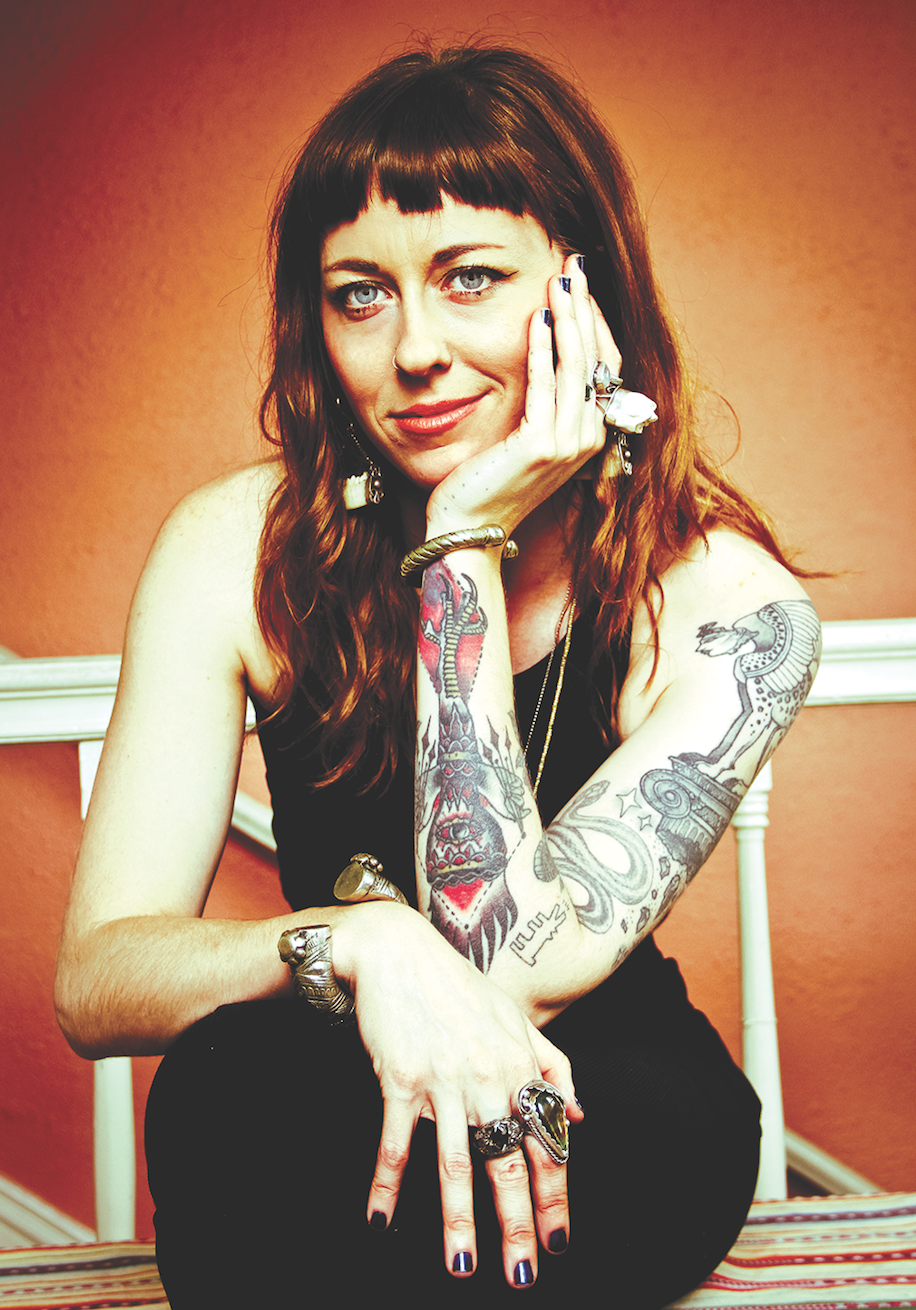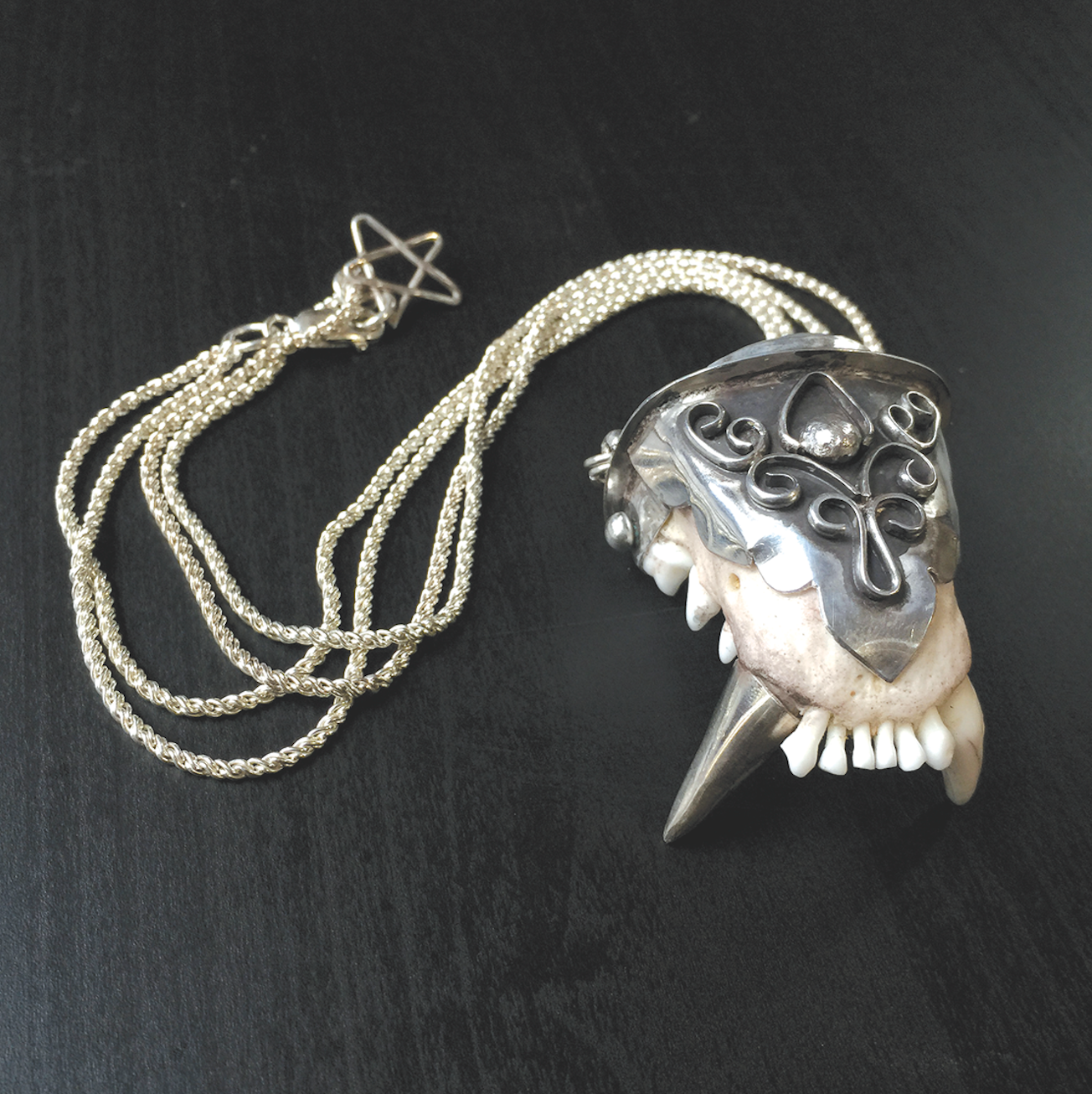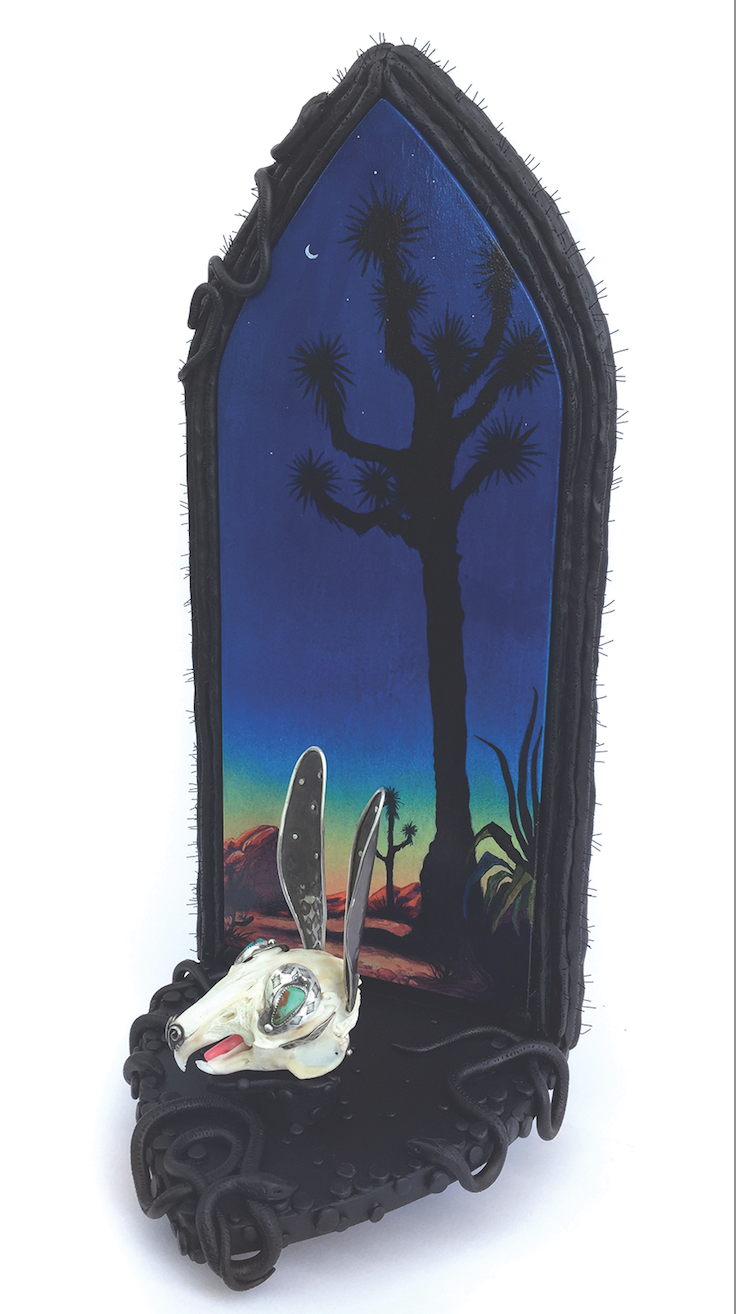Portland artist Morgaine Faye


Morgaine Faye considers herself a visual artist of many stripes. Read on for our interview with the painter, illustrator and metalsmith.
* * *
ELEVEN: You are from Santa Cruz, California originally; what brought you up to Portland?
Morgaine Faye: I was born and raised in Santa Cruz, California. I moved to Portland in 2008. My sister had moved here a few years prior to attend the NCNM, and the first time I came to visit her, it was easy to see that Portland had a ton to offer in terms of art community, spaces to show, and people making interesting and diverse work. I moved here shortly after to attend Pacific Northwest College of Art. Coming from Santa Cruz, which is at the top of the Monterey Bay situated between the soggy redwood mountains and vast sandy beaches. I had easy access to dense forests, bodies of water, and total isolation if I wanted.
11: You are an artist of many different styles. Is there a type of visual artist that you would consider yourself to be? What is the name of the style of art that you make?
MF: I consider myself a “visual artist,” which is just a handy catch-all to say that I like to make things in a variety of media. The activity that takes up most of my time day-to-day is working on my jewelry line and keeping up with the demand from the shops that sell my work. I also spend as much time as I can making personal work for the handful of gallery shows I participate in each year. I haven’t been working animations lately, but it’s true that I occasionally work on projects for the stop-motion studio Bent Image Lab, and I have been able to work on many fun projects with them creating puppets, props, sets, storyboards, and all manner of other strange things, in miniature.
I wouldn’t say there is any one style I work in, necessarily. I can say that I get a ton of inspiration from ancient artifacts, religious relics and iconography from cultures all over the world. I hope that rather than a style, my work has a cohesive voice. My work doesn’t really resemble what it did even three years ago, but it all comes from the same place, and I think you can see that.
11: Tell us a little about the artistic evolution and progression that you have been through, from drawing to painting to sculpting.
MF: Drawing is what got me hooked on making art. Or rather, it was watching cartoons and playing video games that made me want to draw, and it was drawing that made me want to become an animator (or so I thought.) I was lucky enough to be encouraged from a young age to develop my creative skills. I can’t express how lucky I feel to have that. So many creative kids are actively stifled, and it breaks my heart. I feel so appreciative I had people around me telling me it wasn’t a total waste of time. In school I took every art class they offered, I knew I wanted to go to art school because I wanted to become a really technical painter (or so I thought.) To save money on tuition, I took a bunch of core classes at my local community college, that’s where I took two years of small scale metals and jewelry fabrication classes. That had an enormous impact on opening up avenues for my work.
I transferred to PNCA, struggled in a painting department where I didn’t feel like I belonged. And then switched over to the illustration department where things finally clicked for me. It was client based, and commercially rooted, and it helped me learn how to market my work. This was key if I was going to make this art career thing work. After I graduated in 2011, and I could make whatever the hell weird thing I wanted, I began saving up for jewelry tools one by one and built my studio. After a huge gap in even touching a smithing torch, I began making and selling jewelry since 2013, and I have been self-employed since 2014.
11: What is the significance of nature in your work?
MF: Nature has always been the strongest theme and influence on my work–it’s the original art! I also use themes in nature to create my own personal narratives. I use nature as a sort of coded language, which allows me to feel safe while expressing personal ideas. I also appreciate and fear the duality of nature. It is both life-giving and life-taking. Nature is beautiful and cruel and perfect and here we are slowly destroying it.

11: In some of your work, you describe your art as being taken from elements of nature and in a state of decay,and that at times it is your intention to make people feel uncomfortable? Why is that? What can people learn from their feelings of discomfort?
MF: Part of it might be to share my own discomfort. Kind of spread it around, if you will. I think that most of the discomfort people feel from my work stems from their own fears of illness and death. I can understand that. What my work is suggesting is that you cannot hide from these things. They are ever-present whether you choose to see them or not. I also feel that humans have to face that fact that we are responsible for so much destruction of the earth. Mistreatment of animals, poisoning our own water systems. We do it to ourselves. I think people would rather ignore unpleasant aspects of life, hide the garbage, hide the sick and old. I’m encouraging the viewer to take a peek at the icky insides.
11: How do you find the bones and stones for your work? Do you go after particular stones or skeleton pieces specifically for symbolism or are they found in nature and incorporated sporadically?
MF: The majority of the bones in my work are collected by me. I am a scavenger by nature and am always looking for remains even if I am walking in the city. When I am hiking, camping, or traveling I am always scouting for remains and other treasures I can collect and use for my work. The roads are an abundant resource, sadly. I have also made a few like-minded scavenger friends. Other artists who also work with found bones. I will often trade with these folks if I am looking for something specific. The stones come from just about everywhere. I have only recently began tumbling the stones I pick up locally, but I have amassed a nice collection of rocks and gemstones over the years. I prefer to buy from the stone-cutters themselves. I occasionally will cut or reshape a stone, but lapidary work is an art in and of itself, so I leave the stone cutting to the pros.
11: What got you into making jewelry? How does the aspect of consumerism affect the type that you make?
MF: Jewelry making started when I was younger and I began making my large and colorful beaded earrings. As a collector, jewelry has always been a way for me to put my collections and collective habits to work for me, rather than just accumulating this mass of curious stuff for my own shits and giggles. I find an enormous amount of beauty in worn down, used objects, things that once had a life. Rather than let these things live on a shelf, or be lost, making them into wearable art is a way to memorialize and tell a story. I am still figuring out how consumerism influences this practice. Generally, I feel like my jewelry isn’t for the faint of heart. It won’t appeal to most people. Tending to land on the side of being very large, aggressive, and made with dead things, it’s not everyone’s taste. That being said, there are a ton of people out there who find teeth and bones as beautiful as I do, and there are even more who bring me their own treasures to be immortalized in jewel form. People have brought me their pet’s or baby’s teeth, relics they have found themselves. And these are some of the projects that I love the most. I love being able to make keepsakes for people. I like to think about the life my work goes on to live when people take it home. Maybe my favorite part of the job.
11: Tell us about your newest work that you have up at the Antler Gallery.
MF: My latest body of work, “Vigor Mortis,” consists of six intricately hand-crafted reliquary sculptures that house bejeweled animal skulls, ornamented with fine silver components and transformed into wearable jewelry. Created using traditional silver smithing techniques, the bejeweled skulls are reminiscent of the jeweled corpse kings of Austria, or Tibetan ceremonial kapala skulls. Behind each skull is a vibrant landscape painting housed in a hand sculpted frame, creating a “window” into the areas where each animal skull was found.
A common theme in my new series is a comment on the unintended consequences of human interactions with animals. Many of the skulls were sourced from road kills. I wanted to bring them back to life, in a way. Memorialize and bestow them on high regard by adorning them, and giving them a beautiful final resting place.
11: Is there any advice you might have for any up and coming artists that would like to get their work out to our community?
MF: Yes! If I could share any advice for someone wanting to get their art out into Portland, I would say that first you’ve gotta show up! Go to shows, show up to events. Meet and ask questions of the people who are making the kinds of work and showing in the spaces you want to show. Nobody is really going to just find you, you have to get out there. Find out who is curating the spaces. Talk to those people about things other than art. People are friendly here.
But my other part of that advice would be, that if you are serious about showing your work, or making any sort of living with your work, you need to look outside of Portland, too. That’s where having a professional online presence is key. There are way larger audiences and art markets to be accessed online. Sharing bits of your process, and what drives your work will engage people and has brought showing opportunities to me I never would have thought to pursue.
But also, don’t worry too much about getting into shows, or how many followers you have if your work isn’t there. Making the work is what’s most important. Develop your skill. Don’t get stuck in a style, and don’t rip other artists. That will hold you back. Focus on making authentic work that you are proud of, and show up! A lot can happen from there.

11: Who are your artistic inspirations or influences that you have had through your career?
MF: I draw inspiration from so many sources: ancient jewelry, cultural history, weapons and armor from all over the world, religious iconography, music, and of course my influences as a child that I mentioned earlier. I really try to draw from realms that are outside of contemporary art. Though, of course I am inspired by many artists as well. Wangechi Mutu comes to mind because I saw her speak earlier this year. Her work deals with many of the same themes as mine. So many more: Gottfried Helnwein, Lucia Mathews, Egon Scheile. The jewelry collaborations of Georges Foquet and Alphonse Mucha, designers like Alexander McQueen have impacted me as well. Many of my favorite pieces of art were made by unknown artists though. The giant Lamassu statues, which were destroyed by ISIS last year, being one of them.
11: Tell us about your upcoming projects.
MF: I am gearing up for a pair of shows that center around the theme of “Growth and Decay.” I will be making two pieces, one on the theme of growth, will be displayed in Paradigms gallery in Philadelphia, and the other decay-themed piece will be exhibited at Antler Gallery here in Portland.
After that I will be beginning a new personal body of work. I have some ideas I need to get out. Think similar to the reliquaries but on a much larger scale. And also some exciting new developments for my jewelry line.
11: Is there anything you would like to add?
MF: You may find my work in several galleries and boutiques around Portland. Antler Gallery, on NE Alberta shows nature inspired fine art from all over. Paxton Gate, an amazing natural wonders and curiosity shop on N. Mississippi, and also Altar on Hawthorne, which sells locally-made alternative clothing, jewelry and wares. »
– Lucia Ondruskova



